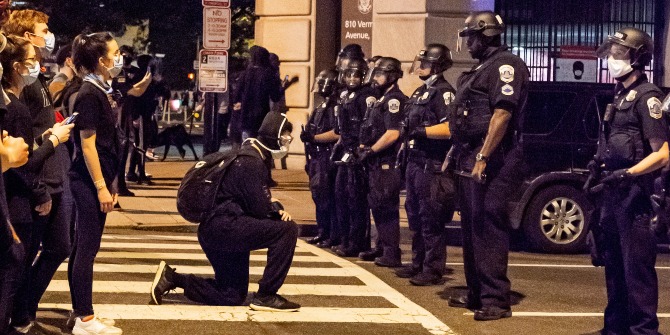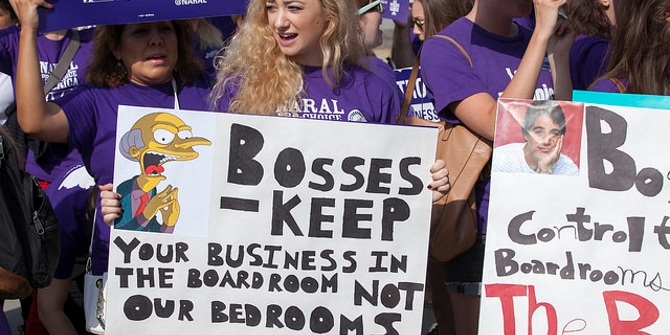 Following the death of Freddie Gray in police custody last week, this week has seen rioting in Baltimore and protests across the country decrying police brutality towards the black population. Richard Rothstein argues that while improvements in police quality are needed, the roots of the unrest go deeper, having been shaped by the history of intentional segregation in Baltimore and other cities like it. He writes that without suburban integration to address ghetto conditions, Baltimore’s riots are unlikely to be the last.
Following the death of Freddie Gray in police custody last week, this week has seen rioting in Baltimore and protests across the country decrying police brutality towards the black population. Richard Rothstein argues that while improvements in police quality are needed, the roots of the unrest go deeper, having been shaped by the history of intentional segregation in Baltimore and other cities like it. He writes that without suburban integration to address ghetto conditions, Baltimore’s riots are unlikely to be the last.
In Baltimore in 1910, a black Yale law school graduate purchased a home in a previously all-white neighborhood. The Baltimore city government reacted by adopting a residential segregation ordinance, restricting African Americans to designated blocks. Explaining the policy, Baltimore’s mayor proclaimed, “Blacks should be quarantined in isolated slums in order to reduce the incidence of civil disturbance, to prevent the spread of communicable disease into the nearby White neighborhoods, and to protect property values among the White majority.”
Thus began a century of federal, state, and local policies to quarantine Baltimore’s black population in isolated slums—policies that continue to the present day, as federal housing subsidy policies still disproportionately direct low-income black families to segregated neighborhoods and away from middle class suburbs.
Whenever young black men riot in response to police brutality or murder, as they have done in Baltimore this week, we’re tempted to think we can address the problem by improving police quality—training officers not to use excessive force, implementing community policing, encouraging police to be more sensitive, prohibiting racial profiling, and so on. These are all good, necessary, and important things to do. But such proposals ignore the obvious reality that the protests are not really (or primarily) about policing.
In 1968, following hundreds of similar riots nationwide, the Kerner Commission appointed by President Lyndon Johnson concluded that “[o]ur nation is moving toward two societies, one black, one white—separate and unequal” and that “[s]egregation and poverty have created in the racial ghetto a destructive environment totally unknown to most white Americans.” The Kerner Commission (headed by Illinois Governor Otto Kerner) added that “[w]hat white Americans have never fully understood—but what the Negro can never forget—is that white society is deeply implicated in the ghetto. White institutions created it, white institutions maintain it, and white society condones it.”
In the last 50 years, the two societies have become even more unequal. Although a relatively small black middle class has been permitted to integrate itself into mainstream America, those left behind are more segregated now than they were in 1968.
When the Kerner Commission blamed “white society” and “white institutions,” it employed euphemisms to avoid naming the culprits everyone knew at the time. It was not a vague white society that created ghettos but government—federal, state, and local—that employed explicitly racial laws, policies, and regulations to ensure that black Americans would live impoverished, and separately from whites. Baltimore’s ghetto was not created by private discrimination, income differences, personal preferences, or demographic trends, but by purposeful action of government in violation of the Fifth, Thirteenth, and Fourteenth Amendments. These constitutional violations have never been remedied, and we are paying the price in the violence we saw this week.
Following the police killing of Michael Brown in Ferguson, Missouri, last August, I wrote the report, The Making of Ferguson, a history of the state-sponsored segregation in St. Louis County that set the stage for police-community hostility there. Virtually every one of the racially explicit federal, state, and local policies of segregation pursued in St. Louis has a parallel in policies pursued by government in Baltimore.

In 1917, the U.S. Supreme Court found ordinances like Baltimore’s 1910 segregation rule unconstitutional, not because they abridged African Americans’ rights to live where they could afford, but because they restricted the property rights of (white) homeowners to sell to whomever they wished. Baltimore’s mayor responded by instructing city building inspectors and health department investigators to cite for code violations anyone who rented or sold to blacks in predominantly white neighborhoods. Five years later, the next Baltimore mayor formalized this approach by forming an official Committee on Segregation and appointing the City Solicitor to lead it. The committee coordinated the efforts of the building and health departments with those of the real estate industry and white community organizations to apply pressure to any whites tempted to sell or rent to blacks. Members of the city’s real estate board, for example, accompanied building and health inspectors to warn property owners not to violate the city’s color line.
In 1925, 18 Baltimore neighborhood associations came together to form the “Allied Civic and Protective Association” for the purpose of urging both new and existing property owners to sign restrictive covenants, which committed owners never to sell to an African American. Where neighbors jointly signed a covenant, any one of them could enforce it by asking a court to evict an African American family who purchased property in violation. Restrictive covenants were not merely private agreements between homeowners; they frequently had government sanction. In Baltimore, the city-sponsored Committee on Segregation organized neighborhood associations throughout the city that could circulate and enforce such covenants.
Supplementing the covenants, African Americans were prevented from moving to white neighborhoods by explicit policy of the Federal Housing Administration (FHA), which barred suburban subdivision developers from qualifying for federally subsidized construction loans unless the developers committed to exclude African Americans from the community. The FHA also barred African Americans themselves from obtaining bank mortgages for house purchases even in suburban subdivisions which were privately financed without federal construction loan guarantees. The FHA not only refused to insure mortgages for black families in white neighborhoods, it also refused to insure mortgages in black neighborhoods—a policy that came to be known as “redlining,” because neighborhoods were colored red on government maps to indicate that these neighborhoods should be considered poor credit risks as a consequence of African Americans living in (or even near) them.
Unable to get mortgages, and restricted to overcrowded neighborhoods where housing was in short supply, African Americans either rented apartments at rents considerably higher than those for similar dwellings in white neighborhoods, or bought homes on installment plans. These arrangements, known as contract sales, differed from mortgages because monthly payments were not amortized, so a single missed payment meant loss of a home, with no accumulated equity. In the Atlantic last year, Ta-Nehisi Coates described how this system worked in Chicago. Rutgers University historian Beryl Satter described it this way:
Because black contract buyers knew how easily they could lose their homes, they struggled to make their inflated monthly payments. Husbands and wives both worked double shifts. They neglected basic maintenance. They subdivided their apartments, crammed in extra tenants and, when possible, charged their tenants hefty rents. …
White people observed that their new black neighbors overcrowded and neglected their properties. Overcrowded neighborhoods meant overcrowded schools; in Chicago, officials responded by “double-shifting” the students (half attending in the morning, half in the afternoon). Children were deprived of a full day of schooling and left to fend for themselves in the after-school hours. These conditions helped fuel the rise of gangs, which in turn terrorized shop owners and residents alike.
In the end, whites fled these neighborhoods, not only because of the influx of black families, but also because they were upset about overcrowding, decaying schools and crime. They also understood that the longer they stayed, the less their property would be worth. But black contract buyers did not have the option of leaving a declining neighborhood before their properties were paid for in full—if they did, they would lose everything they’d invested in that property to date. Whites could leave—blacks had to stay.
The contract buying system was commonplace in Baltimore. Its existence was solely due to the federal government’s policy of denying mortgages to African Americans, in either black or white neighborhoods.
Nationwide, black family incomes are now about 60 percent of white family incomes, but black household wealth is only about 5 percent of white household wealth. In Baltimore and elsewhere, the distressed condition of African American working- and lower-middle-class families is almost entirely attributable to federal policy that prohibited black families from accumulating housing equity during the suburban boom that moved white families into single-family homes from the mid-1930s to the mid-1960s—and thus from bequeathing that wealth to their children and grandchildren, as white suburbanites have done.
As I described in the Making of Ferguson, the federal government maintained a policy of segregation in public housing nationwide for decades. This was as true in northeastern cities like New York as it was in border cities like Baltimore and St. Louis. In 1994, civil rights groups sued the Department of Housing and Urban Development (HUD), alleging that HUD had segregated its public housing in Baltimore and then, after it had concentrated the poorest African American families in projects in the poorest neighborhoods, HUD and the city of Baltimore demolished the projects, and purposely relocated the former residents into other segregated black neighborhoods. An eventual settlement required the government to provide vouchers to former public housing residents for apartments in integrated neighborhoods, and supported this provision with counseling and social services to ensure that families’ moves to integrated neighborhoods would have a high likelihood of success. Although the program is generally considered a model, it affects only a small number of families, and has not substantially dismantled Baltimore’s black ghetto.

In 1970, declaring that the federal government had established a “white noose” around ghettos in Baltimore and other cities, HUD Secretary George Romney proposed denying federal funds for sewers, water projects, parkland, or redevelopment to all-white suburbs that resisted integration by maintaining exclusionary zoning ordinances (that prohibited multi-unit construction) or by refusing to accept subsidized moderate-income or public low-income housing. In the case of Baltimore County, he withheld a sewer grant that had previously been committed, because of the county’s policies of residential segregation. It was a very controversial move, but Romney got support from Vice President Spiro Agnew, who had been frustrated by unreasonable suburban resistance to integration and mixed income developments when he had been the Baltimore County Executive and Governor of Maryland. In a 1970 speech to the National Alliance of Businessmen, Agnew attacked attempts to solve the country’s racial problems by pouring money into the inner city as had been done in the Johnson administration. Agnew said that he flatly rejected the assumption that “because the primary problems of race and poverty are found in the ghettos of urban America, the solutions to these problems must also be found there… Resources needed to solve the urban poverty problem—land, money, and jobs—exist in substantial supply in suburban areas, but are not being sufficiently utilized in solving inner-city problems.”
President Richard Nixon eventually restrained Romney, HUD’s integration programs were abandoned, Romney himself was forced out as HUD Secretary, and little has been done since to solve the urban poverty problem with the substantial resources that exist in the suburbs.
Ten years ago, during the subprime lending boom, banks and other financial institutions targeted African Americans for the marketing of subprime loans. The loans had exploding interest rates and prohibitive prepayment penalties, leading to a wave of foreclosures that forced black homeowners back into ghetto apartments and devastated the middle class neighborhoods to which these families had moved. The City of Baltimore sued Wells Fargo Bank, presenting evidence that the bank had established a special unit staffed exclusively by African American bank employees who were instructed to visit black churches to market subprime loans. The bank had no similar practice of marketing such loans through white institutions. These policies were commonplace nationwide, but federal bank examiners responsible for supervising lending practices made no attempt to intervene. When a similar suit was filed in Cleveland, a federal judge observed that because mortgage lending is so heavily regulated by the federal and state governments, “there is no question that the subprime lending that occurred in Cleveland was conduct which ‘the law sanctions’.”
Baltimore, not at all uniquely, has experienced a century of public policy designed, consciously so, to segregate and impoverish its black population. A legacy of these policies is the rioting we have seen this week. Whether after the 1967 wave of riots that led to the Kerner Commission report, after the 1992 Los Angeles riot that followed the acquittal of police officers who beat Rodney King, or after the recent wave of confrontations and vandalism following police killings of black men, community leaders typically say, properly, that violence isn’t the answer and that after peace is restored, we can deal with the underlying problems. We never do so.
Certainly, African American citizens of Baltimore were provoked by aggressive, hostile, even murderous policing, but Spiro Agnew had it right. Without suburban integration, something barely on today’s public policy agenda, ghetto conditions will persist, giving rise to aggressive policing and the riots that inevitably ensue. Like Ferguson before it, Baltimore will not be the last such conflagration the nation needlessly experiences.
This article originally appeared at The Economic Policy Institute.
Please read our comments policy before commenting.
Note: This article gives the views of the authors, and not the position of USApp– American Politics and Policy, nor of the London School of Economics.
Shortened URL for this post: http://bit.ly/1I15139
_________________________________
About the author
 Richard Rothstein – Economic Policy Institute
Richard Rothstein – Economic Policy Institute
Richard Rothstein is a research associate of the Economic Policy Institute.







1 Comments